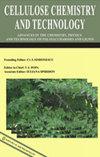"DEVELOPMENT OF WOOD GRINDING 5. FINES CONTENT–TO–SHIVES RATIO "
IF 1.1
4区 农林科学
Q2 MATERIALS SCIENCE, PAPER & WOOD
Cellulose Chemistry and Technology
Pub Date : 2022-11-29
DOI:10.35812/cellulosechemtechnol.2022.56.82
引用次数: 0
Abstract
"Data by Riissanen were largely applied to learn more about wood grinding and, particularly, possible effects of the moisture content in spruce wood, varying from 65 to 15%, which in terms of moisture ratio covers a range from 1.9 to 0.2 kg water per kg oven dry wood. Tensile index (TI) and light scattering coefficient (LSC) of the pulp sheets were tested corresponding to various wood moisture contents, when the wood samples were ground to pulp by application of 20 and 30 m/s stone surface speeds and 0.7, 1.0 and 1.3 mm/s wood feed rates, respectively. The fines quantity of the screened pulp was related to the shives quantity that was screened off before testing, and accordingly these data were imitating some relevant grinding conditions. Fines were considered indicative of the fibrillation, as shives were indicative of the average fibre length. The respective TI and LSC values were correlated to the fines content–to–shives ratio for some useful results. The highest TI were obtained with fully water impregnated spruce wood (65% MC) by application of 30 m/s stone surface speed, and the lowest with air-dry wood (15% MC) and 30 m/s as well. Fresh spruce wood (58% MC) resulted in a similar trend as obtained with fully water impregnated wood, but on a lower level. Slightly dried spruce wood (44% MC) showed a further lower level, but surprisingly 30 m/s resulted in lower TI values than 20 m/s stone speed. Spruce wood with water saturated fiber walls (28% MC) appeared to react strongly to 20 m/s, but not to 30 m/s stone surface speed. The LSC values appeared quite contrary to the TI values, i.e. the highest LSC values were obtained by grinding the air-dry spruce wood (15% MC), while the fully water impregnated wood (65% MC) again gave the lowest LSC, when grinding at 20 m/s stone surface speed. "木材磨削的发展罚款内容与碎片比率”
“Riissanen的数据主要用于了解更多关于木材磨削的信息,特别是云杉木材中水分含量的可能影响,从65%到15%不等,就水分比例而言,每公斤干燥木材的水分含量范围为1.9到0.2公斤。分别以20和30 m/s的石料表面速度和0.7、1.0和1.3 mm/s的木材进料速度磨成纸浆,测试不同木材含水率下纸浆片的拉伸指数(TI)和光散射系数(LSC)。筛浆的细粒数与试验前筛出的碎粒数有关,因此这些数据模拟了一些相关的磨矿条件。细粒被认为是纤维性颤动的指示,因为细粒是纤维平均长度的指示。对于一些有用的结果,各自的TI和LSC值与细粒含量与碎屑比相关。在30 m/s的石材表面速度下,全水浸渍云杉木材(65% MC)的TI最高,在30 m/s的石材表面速度下,风干木材(15% MC)的TI最低。新鲜云杉木材(58% MC)与完全浸水的木材产生了相似的趋势,但水平较低。稍微干燥的云杉木材(44% MC)显示出更低的水平,但令人惊讶的是,30 m/s的速度比20 m/s的石头速度导致的TI值更低。水饱和纤维壁的云杉(28% MC)对20 m/s的表面速度反应强烈,但对30 m/s的表面速度反应不强烈。LSC值与TI值完全相反,即风干云杉木材(15% MC)的LSC值最高,而完全浸水的木材(65% MC)在20 m/s石材表面速度下研磨时LSC值最低。
本文章由计算机程序翻译,如有差异,请以英文原文为准。
求助全文
约1分钟内获得全文
求助全文
来源期刊

Cellulose Chemistry and Technology
工程技术-材料科学:纸与木材
CiteScore
2.30
自引率
23.10%
发文量
81
审稿时长
7.3 months
期刊介绍:
Cellulose Chemistry and Technology covers the study and exploitation of the industrial applications of carbohydrate polymers in areas such as food, textiles, paper, wood, adhesives, pharmaceuticals, oil field applications and industrial chemistry.
Topics include:
• studies of structure and properties
• biological and industrial development
• analytical methods
• chemical and microbiological modifications
• interactions with other materials
 求助内容:
求助内容: 应助结果提醒方式:
应助结果提醒方式:


